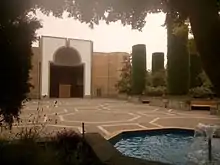The Ismaili Centre, Burnaby
The Ismaili Centre, Burnaby is one of six such centres worldwide. It was the first purpose-built Ismaili jamatkhana and the first Ismaili centre in North America.[1][2] It has accordingly been the subject of sustained, dedicated academic analysis, being noted as a case-study of modern Islamic architecture in the West.[3][4][5][6]
| The Ismaili Centre, Burnaby | |
|---|---|
 | |
| Religion | |
| Affiliation | Nizari Ismaili Muslim |
| Leadership | His Highness the Aga Khan |
| Location | |
| Location | 4010 Canada Way, Burnaby, Metro Vancouver, British Columbia, Canada |
| Geographic coordinates | 49.25415°N 123.01373°W |
| Architecture | |
| Architect(s) | Bruno Freschi |
| Type | Jamatkhana |
| Groundbreaking | 26 July 1982 |
| Completed | 1985 |
| Website | |
| https://the.ismaili/microsite/burnaby | |
Foundation
'The site in Burnaby was acquired in 1979, for it was here that the first Ismaili congregation was established in Canada.'[7] The foundation ceremony for the new building was held on 26 July 1982,[8] and construction was completed in 1985, during the silver jubilee of Aga Khan IV;[9] the new building was opened by the former Canadian Prime Minister Brian Mulroney.[10] The building was conceived as an 'ambassadorial building' aiming to give visual architectural expression to the expanding Ismaili community in Canada, and designed 'not just for the use of the members of the Ismaili community, but [...] to become part of the fabric of the civil life of the area'.[11]
Architecture
Designed by the Vancouver architect Bruno Freschi,[12][13] the Centre has been described as 'monumental',[14] 'spectacular'[10] and 'sitting harmoniously' within its environment, reflecting 'traditional Islamic architectural vocabulary in modern context, materials, and craftsmanship'.[15] Its footprint is 3,870 square metres (41,600 square feet), with a basement containing offices and classroom space, and two upper floors, a double-height prayer-hall (reserved for Ismaili worship) and a multi-purpose hall, around a courtyard with a fountain.[16] The prayer-hall is roofed with a series of shallow Turkish-style domes.[17] The design 'attracted international plaudits'.[18]
Practice
Jamatkhana (sometimes simply khana) is a sacred place for Ismaili Muslims to pray and to learn. After the praying has finished they have a socializing period. During that period of time they sometimes have refreshments and food.
References
- Salima Versi, 'Make This Your Home: The Impact of Religion on Acculturation: The Case of Canadian Khoja Nizari Isma‗ilis from East Africa' (unpublished MA thesis, Queen‘s University Kingston, 2010), pp. 22, 52
- Parin Dossa, 'Women's Space/Time: An Anthropological Perspective on Ismaili Immigrant Women in Calgary and Vancouver', Canadian Ethnic Studies/Etudes Ethniques au Canada, 20.1: 45.
- Roger Kemble, ' "Ethnic eloquence: Burnaby Jamatkhana, Burnaby, B.C. architect: Bruno Freschi": Critique', Canadian Architect, 30:6 (1985), 12-17.
- Bernner Douglas, 'Ismaili Jamatkhana and Center, Burnaby, BC', Architectural Record, 174 (August 1986), 90.
- Hafiz-Ur-Rehman Sherali, 'Architectural Culture of Islamic Institutions in the West' (unpublished Master of Architecture thesis, Massachusetts Institute of Technology, 1991), esp. pp. 179-219; http://hdl.handle.net/1721.1/41322.
- Zamila R. Karimi, 'Spaces of Worship in Islam in the West', Interiors, 1.3 (2010), 265–80 (esp. pp. 273-78); DOI: 10.2752/204191210X12875837764174.
- "About the Ismaili Centre, Burnaby". the.Ismaili. 2009-09-29. Retrieved 2017-07-15.
- Khalil Karim Pirani, 'In Search of Appropriate Architecture: A Jamat Khana in Hunza, Pakistan' (unpublished Master of Architecture dissertation, Massachusetts Institute of Technology, 1989), p. 3 fn. 2. https://dspace.mit.edu/bitstream/handle/1721.1/76872/20448977-MIT.pdf.
- Daryoush Mohammad Poor, Authority without Territory: The Aga Khan Development Network and the Ismaili Imamate (New York: Palgrave Macmillan, 2014), p. 183.
- Karim H. Karim, 'Pluralism, Migration, Space and Song: Ismaili Arrangements of Public and Private Spheres', in Diverse Spaces: Identity, Heritage and Community in Canadian Public Culture', ed. by Susan L. T. Ashley (Newcastle Upon Tyne: Cambridge Scholars Publishing, 2013), pp. 148-69 (at p. 155); https://www.academia.edu/14002048.
- Daryoush Mohammad Poor, Authority without Territory: The Aga Khan Development Network and the Ismaili Imamate (New York: Palgrave Macmillan, 2014), pp. 136-37.
- Bruno Freschi, 'Burnaby Jamatkhana', Architecture and Urbanism (A+ U), 190 (July 1986), p 51.
- Harold Kalman, Robin Ward, and John Roaf, Exploring Vancouver: The Architectural Guide (Vancouver: D & M Publishers, 2012), p. 296.
- Tekijät Tazim R. Kassam, Songs of Wisdom and Circles of Dance: Hymns of the Satpanth Ismā'īlī Muslim Saint, Pīr Shams (Albany, N.Y.: State University of New York Press, 1995), p. 7.
- Zamila R. Karimi, 'Spaces of Worship in Islam in the West', Interiors, 1.3 (2010), 265–80 (p. 276); DOI: 10.2752/204191210X12875837764174.
- Zamila R. Karimi, 'Spaces of Worship in Islam in the West', Interiors, 1.3 (2010), 265–80 (quoting p. 276); DOI: 10.2752/204191210X12875837764174.
- Hasan-Uddin Khan, 'The Art and Architecture of the Mosque', in A Companion to the Muslim World, ed. by Amyn B. Sajoo (London: Tauris, 2009), pp. 177-208 (p. 204).
- Amir Hussain and Jamie S. Scott, 'Muslims', in The Religions of Canadians, ed. by Jamie S. Scott (Toronto: University of Toronto Press, 2012), pp. 167-218 (p. 192).
External links
| Wikimedia Commons has media related to Ismaili Centre, Burnaby. |
- 'Photo Gallery of the Ismaili Jamatkhana and Centre, Burnaby, Canada', Simerg – Insights from Around the World (April 11 2009)